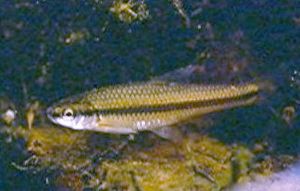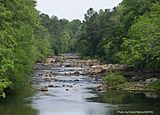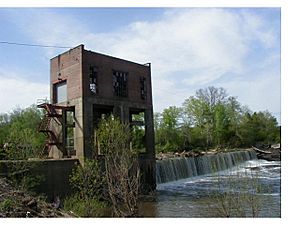Cape Fear shiner facts for kids
Quick facts for kids Cape Fear shiner |
|
|---|---|
 |
|
| Conservation status | |
| Scientific classification | |
 |
|
| Counties in North Carolina in which the Cape Fear Shiner is found; green indicates presence |
The Cape Fear shiner (Notropis mekistocholas) is a small freshwater fish found in North America. It belongs to the minnow family, called Cyprinidae. This fish lives only in the central part of North Carolina in the southeastern United States. You can find it in the shallow streams of the Cape Fear River basin.
The Cape Fear shiner is a small, yellow fish. It has black lips and a black stripe along its side. It often swims in groups with other minnow species. This shiner is special because it has very long intestines. These intestines help it eat mostly plants. It can lay eggs twice a year and usually lives for two or three years. Males and females look similar, but their colors change during the breeding season. Scientists first discovered this fish in 1962.
This shiner is a critically endangered animal. This means there are very few of them left. Its home is threatened by dam building and pollution. It was first listed as threatened in 1987. There have been successful programs to breed these fish in zoos. Also, a dam that hurt their habitat was removed. However, only five groups of these fish still live in the wild. Some experts worry that one big chemical spill could wipe out all of them.
Contents
About the Cape Fear Shiner
How it Got its Name
Scientists discovered the Cape Fear shiner in 1962. Franklin F. Snelson Jr. officially described it in 1971. Its scientific name, mekistocholas, comes from ancient Greek words. Mēkistos means 'longest' or 'very long'. Cholas means 'intestines'. This name describes the fish's very long intestines.
This fish is part of the carp and minnow family, Cyprinidae. Within this family, it belongs to the group called Notropis. This group includes many minnows from eastern North America. The Cape Fear shiner's long, twisted intestines are unusual for its group. This special feature helps it eat mostly plants. It looks different from other minnows in its group. It has a unique mouth shape, head shape, and a black edge on its lower lip.
What it Looks Like
The Cape Fear shiner is a small, sturdy minnow. It is about 5 centimeters (2 inches) long. The longest one ever found was about 7.7 centimeters (3 inches). It is mostly silvery-yellow. It has a black stripe running down its side to its tail area. There is a lighter stripe above the black one. The edges of its scales are black.
The shiner's fins are clear or yellow and somewhat pointed. During the time they lay eggs, males turn more golden. Females become more silvery. The shiner's snout is pointed and rounded. It has a black upper lip and a thin black bar on its lower lip. The upper lip always hangs over the lower lip.
This fish has teeth only at the back of its throat, near its gill arches. These are called pharyngeal teeth. Its eyes are a medium size and are on the side of its head. You can often see its long, dark, coiled intestines through its belly. It also has a special black lining inside its body.
Where it Lives

The Cape Fear shiner lives only in the Upper Basin of the Cape Fear River in North Carolina. There are only five known groups of these fish living in the wild. These groups are found in the Deep, Haw, and Rocky rivers. These rivers are in Chatham, Harnett, Lee, Moore, and Randolph counties. The biggest group lives where the Deep and Rocky Rivers meet.
In winter, shiners might move from the main river channels to smaller streams. This shiner lives in the smallest area of any fish in its group. It usually lives in clean streams. It prefers areas with gravel, rocks, and boulders. It especially likes places where plants like water willows and riverweed grow. These plants help protect it from other fish. The shiner rarely goes into water deeper than 0.5 meters (1.6 feet). It has been seen in slow-moving water, fast-moving sections, and calm pools.
What it Eats and How it Behaves
The Cape Fear shiner often swims in mixed groups with other minnow species. However, it is never the most common fish in these groups. In captivity, it has lived for six years. But in the wild, it usually lives for only two or three years.
The shiner's intestines are made to help it digest plants. Because of this, scientists first thought it ate only plants. But newer studies show that it eats both plants and animals. It eats dead bits of plants and animals, tiny living things like bacteria and phytoplankton, and algae.
Other fish like crappie, bass, and the Flathead Catfish hunt the shiner. Adult Flathead Catfish do not pose a big threat because they live in different parts of the river. But young catfish live in the same areas as the shiner and might be a bigger danger.
This shiner lays its eggs around May 15. This happens when the water temperature reaches about 19 °C (66.2 °F). They might lay eggs a second time in late summer. Both males and females change color when they lay eggs. The male also grows small bumps on its upper body. The shiner usually moves to slower pools to lay its eggs on rocky surfaces. The eggs hatch after three days. The young fish live off their egg yolk for another five days. Young shiners are often found in slow water. They like to hide among large rocks in the middle of a stream or in flooded areas. Young shiners become ready to have their own babies after their first year.
Protecting the Cape Fear Shiner
The Cape Fear shiner is only found in five different groups. Two of these groups are very small and could disappear completely. The other three groups are more stable. They are thought to have between 1,500 and 3,000 adult fish that can have babies.
The Cape Fear shiner was listed as "Endangered" on September 25, 1987. This means it is protected by the Endangered Species Act. Since 1987, the number of shiners and the area where they live have gotten smaller. This fish is also protected from being caught and sold by the Lacey Act. Scientists do not think there were ever huge numbers of these fish.
Building dams on the Cape Fear River has put this minnow in danger. Dams cause flooding and destroy the shallow water homes the shiner needs. Having only a few groups of fish that are far apart can also hurt their genes. This can make them less healthy. Water pollution in some areas has also threatened the shiner. Tests show that the shiner is very sensitive to harmful chemicals. Experts believe that one toxic chemical spill could wipe out all the wild shiners.
The United States Fish and Wildlife Service is working to protect this fish. They study the shiner's life in the wild. In 1998, they gave money to help keep a group of shiners at the North Carolina Zoo. Since 1997, these fish have bred easily in captivity. In 2001, about 900 captive-bred shiners were released for a short time. This helped scientists check the water quality in places where they might release more fish later.
In 2005, workers started to remove the Carbonton Dam. This dam had destroyed part of the shiner's home. After the dam was removed in February 2006, the water level went back to normal. This allowed the Cape Fear shiner to move back into several miles of river that the dam had made unlivable. In 2009, the Deep River was checked to find areas to protect or fix. In 2018, the owner of another dam in High Falls suggested removing it. This would help the river for the Cape Fear shiner. But this plan was stopped because some local people did not agree.
See also
 In Spanish: Notropis mekistocholas para niños
In Spanish: Notropis mekistocholas para niños



